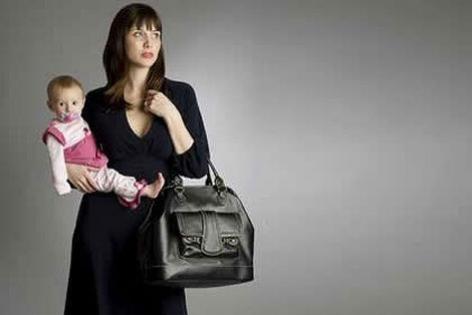60% of a mother’s income is going to childcare when she returns to full-time work after having children, claims new research.
The latest report by Financial services firm AMP and the National Centre for Social and Economic Modelling (NATSEM) factors in the cost of childcare, loss of Government benefits and increase in tax.
Middle income mothers who work part-time fare a little better, losing about 45% of their pay, but mums already working part-time who decide to increase their hours to full-time will lose a massive 75% of their pay for these extra hours of work.
Even though it’s more expensive than ever, childcare use has jumped by almost 80% since 1996, with almost a quarter of all children in some sort of formal childcare, compared to only 13% in 1996.
The report finds Long Day Care is the most common form of formal child care, with 630,000 Australian families using this type of care, but it’s also the most expensive, costing up to $170 a day per child, which is more than a full-time wage for many low income women.
But parents are still more likely to use the services of grandparents, friends and other family members when it comes to caring for their child with 60% opting for this type of informal care.
The average cost of childcare has increased by 150% in the last decade, jumping from $30 to $75 a day for Long Day Care.
AMP Chief Customer Officer Paul Sainsbury said affordability and accessibility of child care is critical to supporting a sustainable society, particularly from a workplace participation perspective as our population ages.
“While Government subsidies have meant out-of-pocket child care expenses haven’t increased by much more than the CPI, the big concern is recent growth in the price charged by child care centres, which has increased by more than 44% in the past five years,” Mr Sainsbury said.
“The AMP.NATSEM report shows child care prices increased more than all but two of the household expenditure categories monitored by the Australian Bureau of Statistics, rising more than education, petrol and health costs. Only electricity and tobacco were higher.”
“When the time comes for parents to decide whether to return to paid work, it’s not only an emotional consideration, but also an important financial one. For some, the decision to return to the workforce may not be a choice, so it’s crucial that Australian families understand the costs involved and the potential impacts of a return to work,” Mr Sainsbury said.
Other key report findings
- Low income and single parents fair the worst with mothers from low income families returning to work full-time, may only keep as little as $4.55 an hour, or 28% of their salary, when factoring in the cost of childcare, loss of Government benefits and income tax.
- Childcare is mostly used by children under five years and peaks for three year olds, where almost 60% of children are in approved childcare.
- Only around 8% of children younger than one-year use approved childcare, this increases dramatically to 34 per cent by the age of one.
- Overall 887,000 families use formal childcare, with nearly 1.3 million children attending around 13,000 approved childcare centres.
- Around 630,000 Australian families use Long Day Care and 109,000 families use Family Day Care (home-based care by registered carers).
- Government covers about 54% of the cost of childcare with the average annual gross cost of child care for an Australian family at $9,315.
- Capital cities tend to offer less affordable child care than regional areas. Outside Western Australian mining centres, Sydney’s affluent Mosman has the least affordable child care, with child care making up 9.3% of disposable income, compared to the 6.5% national average for a family with one child in Long Day Care and one in Outside School Hours Care.
- Queensland has the most affordable child care in Australia, making up about 7% of disposable income in inner Brisbane and 3.7% in Far North Queensland.
- Even though a lot more children now use formal childcare, informal care remains the most popular option with almost 60% of children being looked after by grandparents, relatives or friends.
- Grandparents are playing an increasingly vital role in caring for our kids – covering almost a quarter of all childcare hours.
- Most mothers work part-time with around 42% of mothers with kids in childcare work part-time and 29% work full-time.
- Female workforce participation has increased from around 44 to 59% over the past 35 years, but Australia is still well behind the United Kingdom, Canada and Sweden when it comes to the number of women working compared to men.
- Australia also sits in the middle of international rankings for the number of families using child care, with Denmark and the Netherlands well ahead of the pack.
- When women go back to work after having children, they’re not only faced with covering the cost of child care, but as they increase their working hours, they lose child care benefits and pay more income tax.
- The short-term financial gain of returning to work after having kids can be negligible with a mother from a middle income family only taking home $12.32 of her $30.70 hourly wage when returning to work full-time. Middle income mothers will keep slightly more of their pay if they go back to work part-time – about $16.80 an hour.
NATSEM Principal Research Fellow, and author of the report, Ben Phillips said the report shows Government subsidies, such as, the Child Care Benefit and Child Care Rebate have helped keep a lid on families’ out-of-pockets child care costs.
“Without Government assistance, the gross cost of child care would have doubled compared to incomes and would be 182% above current levels,” Mr Phillips said.
“But it’s likely that – along with higher standards, lack of supply, and Australia’s strong economy – child care subsidies have also helped drive up prices, which means people need more assistance, and so the cycle continues.”
AMP and NATSEM publishes have been publishing these reports since 2002 to help the community make informed financial and lifestyle decisions and to contribute to important social and economic policy debate.

















__small.png)










